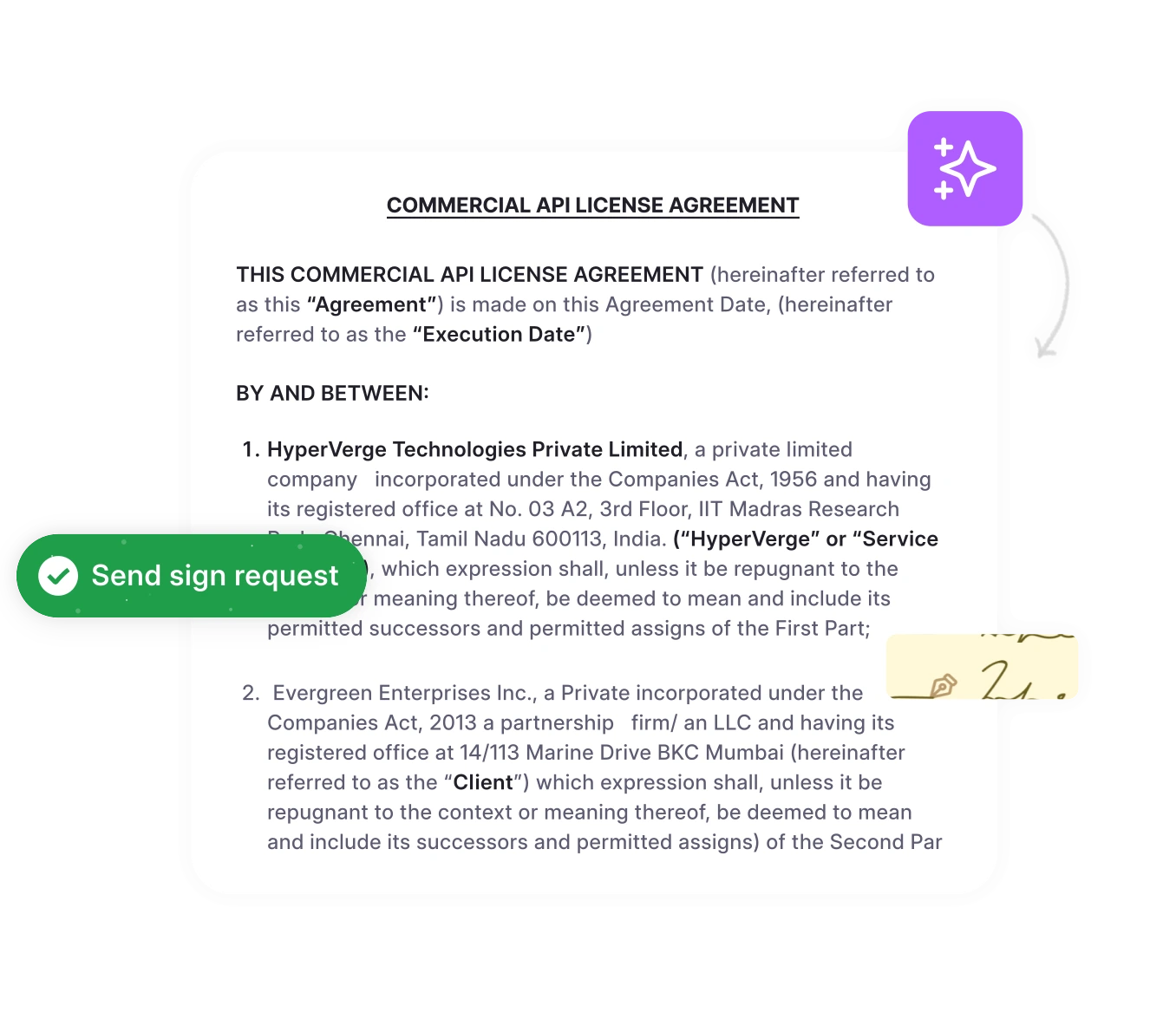Extracting data from contracts helps capture important information. This information is more than just data—it is an overview of your contracting performance and actionable insights that contract managers, legal professionals, and other departments using contracts can leverage to improve their processes.
However, contract data extraction can be tricky, especially with thousands of legacy contracts stored in scattered locations. So, how exactly can organizations turn this scattered data into useful information?
If this is your concern, you are at the right place. This blog offers detailed information on extracting data from contracts—its benefits, process, challenges, and tips. Let’s start.
What is contract data extraction?
Contract data extraction (also known as contract abstraction) is the process of identifying, capturing, processing, organizing and storing data from contractual documents. The data is extracted from the contract’s clauses terms and other elements. It is used by teams like legal, finance, sales, and HR to understand contract management and organizational performance.
Some of the most commonly extracted key data points are:
Contract renewal dates
Contract value
Payment terms
Payment frequency
Termination clause
Jurisdiction
However, how does this extraction and processing process work? Let’s find out
How is contract data extracted?
There are two ways to extract contract metadata: manual and automated contract data extraction. Let’s understand each of these approaches.
Manual data extraction
The contracts are reviewed and analyzed manually.
The data is extracted after analyzing the entire agreement.
The extracted contract data is stored in tools like Excel files and Google Sheets.
Automated data extraction
Automated data extraction helps identify extract process and store contract data without manual effort.
Technologies like Artificial Intelligence (AI) and Optical Character Recognition (OCR) are used for contract data extraction.
Contract management systems built using AI and OCR take digital and paper contracts as input and automatically extract data from contracts
But which of the two methods is better for contract information extraction? Here’s a comparison to help you decide.
| Criteria | Manual Data Extraction | Automated Data Extraction |
| Data Quality | ||
| Extraction Time Efficiency | ||
| Auto-sync With Contract Versions | ||
| Data Processing | ||
| Organization and Storage | ||
| Data Sharing |
The above table clarifies the scope of automated contract data extraction. Contract management software like HyperStart CLM is popularly used for automating contract data extraction.
As per an EY Law survey, 27% of organizations use contract analysis technologies like contract data extraction tools to pull out key contract terms. Wondering why? Keep reading to learn the benefits of automating contract data extraction.
What are the benefits of automating contract data extraction?
Automation enables legal and business teams with limited bandwidth to leverage data without spending days analyzing contracts and capturing key information. By using contract data extraction software, organizations can streamline the contract abstraction process efficiently. Here are a few noteworthy benefits of automating contract data extraction:
1. Enhances data quality
Manual data entry often results in inaccuracies and errors. When legal professionals process large contract volumes maintaining precision is difficult—hampering overall data processing and utilization objectives.
Automation on the other hand helps extract contract information in large volumes with high accuracy.AI contract extraction systems like HyperStart CLM offer 99% accurate extraction through artificial intelligence—ensuring minimal errors, great reliability and zero manual effort.
2. Improves data utilization
After extraction the data must be processed filtered and analyzed. Different departments process contract data in different ways and therefore there is no one way to ensure all departments’ needs are met without extensively working on data processing.
Automating metadata abstraction from contracts helps different business teams utilize data according to their requirements. For example finance teams can extract and process data like contract value payment dates and compliance requirements to manage finances and plan risks better. To understand more read our guide on contract data management.
3. Saves time
Extracting contract elements from thousands of documents is a time-consuming task. If you want to extract information from all your legacy contracts you will need to spend a great deal of time reviewing and processing each document—one contract at a time.
On the other hand automation helps save time by extracting contract data within minutes. Tools like HyperStart CLM offer a smart central contract storage solution that is ready within 48 hours. All the extracted data from legacy contracts is organized and stored in a central contract repository saving time and effort.
4. Offers data visualization
Once extracted the contract data must be turned into meaningful information—often through data visualization. Manually visualizing contract data is challenging because tools like Excel are not designed to analyze and visualize contractual data dynamically.
Automated solutions solve this challenge by offering a visually interactive contract management dashboard. Once extracted the data is automatically processed and visualized into interactive charts and graphs in real time. Each chart redirects to relevant contracts giving you ample visibility and analytical insight.
Extract Contract Data With 99% Accuracy
Dodge manual contract data extraction and deploy HyperStart AI to analyze your contracts. Turn contracts into a data powerhouse.
These are the benefits of using a contract management tool and automating contract data extraction. However, after extracting contract data, how do you use it? Let’s find out in the coming section.
How to use extracted contract data
Contract data is excellent for informed decision-making risk analysis strategy planning and obligation planning. Here are some noteworthy ways to use contract data:
1. To negotiate better deals
Tracking and evaluating data on previous contracts’ value negotiation and payment terms helps understand the market value of an organization’s offerings. Continuously rising contract values and low negotiation rates are useful metrics for negotiating better deals and unlocking new revenue opportunities.
2. To identify bottlenecks
Contract data can help you identify bottlenecks in your contract lifecycle management process. These bottlenecks can be anything—from poorly negotiated deals to a high number of expiration contracts in comparison to renewals. Data helps pinpoint bottlenecks and amend processes for efficiency.
3. To analyze contract KPIs
Contract management KPIs are largely dependent on the extracted data from agreements. Data points like contract value renewal-to-expiration ratio and contract acceptance rate among others are useful indicators of your contract management performance. They help gain actionable insights from contracts and help make decisions that improve efficiency.
4. To plan strategies
Extracting and analyzing contract data is also useful for planning an organization’s strategic initiatives. Contract data can provide information on best and average-performing areas helping to plan strategic priorities understand and minimize risk exposure and get a holistic view of performance.
Now that you know how to leverage the extracted agreement data let’s discuss some tips to help you streamline data extraction and get the most out of your contracts.
However, doing so requires using top-notch contract lifecycle management tools like HyperStart CLM that effectively understand, extract, and analyze contract data.
Save 80% of Contract Admin Time
Automate monotonous contract management tasks and focus on what matters with HyperStart CLM. We are a one-stop solution to help you handle your contracts from start to finish.
3 Tips for efficient contract data extraction
1. Prioritize contract data and metrics
There is no doubt that all contract data is important. However some contract types—such as financial agreements—will have more valuable data than others. Prioritize the most valuable data and ensure its accuracy to ensure that you get powerful contract metrics.
2. Leverage a central repository
A centralized contract repository is useful for handling all legacy and digital contracts in one place. Central repositories help maintain a single source of truth and enable organizations to gain useful insights from a diverse set of contractual data.
3. Make contracts extraction-friendly
To fully leverage contract data capabilities it is important to create extraction-friendly contracts. This means standardizing contracts and converting clauses into structured data. This helps improve AI’s precision in data capturing and makes extraction much easier.
Follow these tips to streamline contract data extraction and make your contract processes data-powered. You only need a contract management automation tool with the right features to extract data from your agreements.
Automate contract data extraction with HyperStart
Contract data holds great potential for improving business processes, gaining contractual insights, and promoting strategic decisions. However, doing so requires using a top-notch contract lifecycle management tool like HyperStart CLM that effectively understands, extracts, and analyzes contract data.
HyperStart CLM is an AI-powered contract management solution that helps you leverage contract information and optimize processes through the power of contractual data. Empower your legal team with our robust, secure, automated data extraction solution and make data-driven decisions.
Ready to experience innovative contract management for yourself? Book a demo with our team today and take the first step toward optimizing your contract processes.
Frequently asked questions
Some of the most common challenges in extracting contractual data are:
- Scattered storage of agreements in multiple locations
- Lack of standard contract formats
- Multiple contract versions with no trace and visibility












